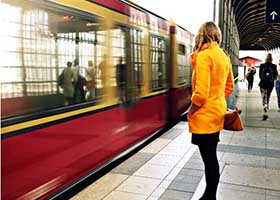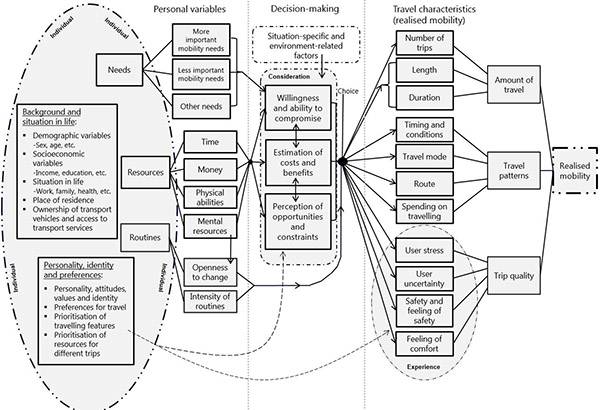Assessing the mobility impacts of upcoming transport inventions is difficult by using realised travel indicators alone. A recent Master of Science thesis, completed as a part of VTT’s methodology development work, introduces a conceptual model describing mobility as potential for travel. Its aim is to make personal mobility easier to approach in practise.
Need for new methods
Major changes are under progress in transport. Managing these changes and transport demand requires a better understanding of daily travel. The concept of mobility is well suited to this purpose, as it comprises much more than actual travel. Defined as the potential for movement, in this context movement of people, it includes possibilities and constraints of travel. It can also include people’s preferences, their feelings and their travel decisions.

Photo: Pexels
However, despite the definition, mobility has usually been measured in terms of realised travel indicators (based on descriptive data of past travel), because the potential for travel is hard to capture. Upcoming transport inventions – such as automated driving and new mobility services – can change the prerequisites of travel and have substantial impacts on mobility. For that reason, trying to assess their future impacts by analysing realised present travel does not give sufficient results. Consideration of the other aspects of mobility besides actual travel can increase our understanding of mobility impacts. To make mobility easier to approach in practise, the thesis elaborated the factors of what mobility consists of in the shape of a conceptual model and discusses its potential use.
Mobility model
The mobility model bases on TeleFOT mobility model – that was also used in the DRIVE C2X and TEAM projects –, which provides a structure for the realised part of mobility. This model was supplemented with specialist interviews and a multidisciplinary literature review on travel behaviour and mobility. It was concluded that mobility consists of personal variables, situation-specific and environment-related factors, decision-making and realised mobility.
Background, life situation, personality and identity shape the needs, resources and constraints related to travel. Personal resources do not comprise of time and money alone but cover different kinds of physical abilities and mental resources alike required from one to travel – such as physical and cognitive capability, energy and skills. It is necessary to keep in mind that individuals perceive and estimate situations and alternatives differently, and they have personal preferences for travel. Still, consideration and decision-making bases on individual’s needs and resources. As people are not purely rational beings, emotions and learned routines affect behaviour. Situation-specific and environment-related factors shape mobility for their part.
As travel happens within travel potential, not all trips are realised. Decision-making defines the amount of travel and the way trips are realised: timing and conditions, mode, route, and so forth. Travel quality should not be ignored either.

Mobility model identifies factors and dimensions of travel potential. Illustration: Kuisma 2017
Next steps
Multiple factors, dimensions and impact mechanisms are involved in mobility. The mobility model is a way to bring them together in a structured manner. The approach can be used in impact assessment by considering what is changing when a new technology or service emerges. For instance, in the case of driving automation levels, mobility impacts could be assessed by determining how the automation levels change travel experience and travel requirements and how these changes respond to the needs, preferences and personal resources of people. Understanding individual needs, preferences, resources and constraints presumes listening to the subjective experiences of people.
Although dealing with subjectivity is a challenge in transport research, mobility impact assessment of upcoming inventions requires learning from the subjective experiences of people. In the thesis, some survey questions focusing on personal preferences, resources and constraints of daily travel were experimented. One interesting result was that over 80% of the respondents told that their daily mobility is restricted to some extent by low energy or lack of coping – which is not typically considered in travel studies at all.
Interviewing is the traditional method for studying subjective experiences, but the challenge lies in finding suitable questions and making appropriate interpretations. The mobility model can support the design of questionnaires by linking it to the theoretical background. Finding methods for mobility impact assessment is a large and ongoing challenge for researchers.
The thesis can be read and downloaded free of charge by using this link.
 Contact:
Contact:
Salla Kuisma
salla.kuisma@vtt.fi
VTT, Finland






Follow us: